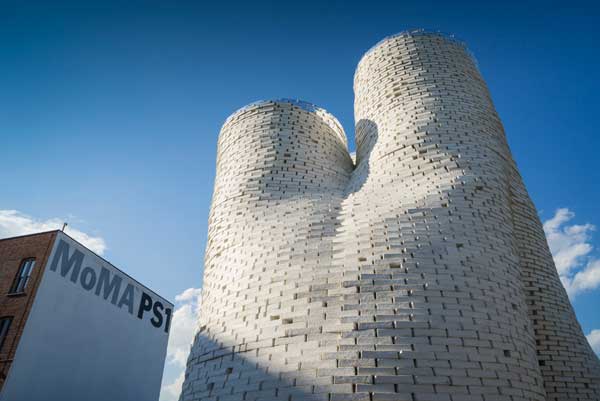
[Image above] Installation view of The Living’s Hy-Fi, the winning project of The Museum of Modern Art and MoMA PS1’s 2014 Young Architects Program. Credit: Kris Graves
Sustainable building materials aren’t just for science anymore.
A new bio-brick installation that marries form with function shows that carbon-friendly construction components can also be award-winning works of art.
Designed by New York architecture-design firm The Living, Hy-Fi is an impressive-looking tower of bricks made from mushrooms and corn stalks.
Yes, you heard right. The scraps from your dinner table and cornfield aren’t trash, they’re treasure. Dorothy—we’re not in Kansas anymore.
(Corn seems to be a hot topic this month. Catch corn’s cover-girl turn in the August ACerS Bulletin. Inside, authors I.A. Cornejo, S. Ramalingam, J.S. Fish, and I.E. Reimanis explore new research that shows glass and glass-ceramics can be made using only mineral content of food waste ash.)
These 100-percent organic—and thus, 100-percent compostable—bricks are made of corn that is dyed clay-red and held together by a mushroom “glue.” The biodegradable brainchild of Ecovative Design (Green Island, N.Y.), the company’s high-performance Mushroom Materials are part-agricultural byproducts and part-mushroom mycelium (i.e., “a natural, self-assembling glue, digesting crop waste to produce cost-competitive and environmentally responsible materials that perform”).
According to an Ecovative press release, David Benjamin, principal of The Living, knew early on that he wanted to incorporate the company’s renewable materials into the organic blocks that would help shape the design of Hy-Fi.
Hi-Fy isn’t the only project to incorporate Ecovative’s material from mushrooms. According to the company, designers around the globe are working to incorporate the sustainable substance into high-end lampshades, plant holders, and an eco-friendly surfboard dubbed “El Portobello.”
Working with the company to prototype and test Benjamin’s bio-bricks resulted in the manufacture (to scale) of the more than 10,000 bricks that would bring the 40-foot tower to (renewable) life.
The bio-bricks that form the Hi-Fy’s three “arteries” also boast a special reflective film developed by 3M. A press release from the Museum of Modern Art (MoMA), where the installation is currently on display, says that the mirror film will be used as growing trays, and, ultimately, shipped back to 3M for “use in further research.”
What makes this mountain of mushrooms and corn stalks stand out from less-sustainable structures?
According to the release, “The structure inverts the logic of load-bearing brick construction and creates a gravity-defying effect—instead of being thick and dense at the bottom, it is thin and porous at the bottom. The structure is calibrated to create a cool micro-climate in the summer by drawing in cool air at the bottom and pushing out hot air at the top.”
It’s both brains and beauty, and its sleek, space-like design—which has nearly no carbon footprint—was recognized by MoMA PS1, which declared Hi-Fy the winner of the museum’s 15th Young Architects Program.
“It is the first sizable structure to claim near-zero carbon emissions in its construction process, and, beyond recycling, it presents itself as being 100% compostable,” says Pedro Gadanho, MoMA curator. “Recurring to the latest developments in biotech, it reinvents the most basic component of architecture—the brick—as both a material of the future and a classic trigger for open-ended design possibilities.”
If you’re in the New York area, you can check out Hi-Fy for yourself. The winning project is a “temporary urban landscape,” providing shade and shelter to visitors at MoMA PS1’s courtyard until September 6.
Time is of the essence though—at the conclusion of its run at MoMA, Hi-Fy, in the ultimate act of sacrificial sustainability, will be composted and converted to fertilizer.
To read fellow editor and patron of the arts April’s recent post on some additional—and artistic—air pollution solutions, head over here. If that’s not enough beauty, check out these ancient Chinese ceramics that prove that the lines between art and science are indeed blurred.



